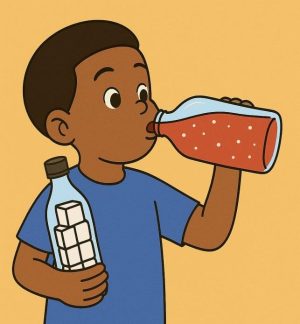
By Eline GADEGBEKU
Who doesn’t like to sip on a soft drink or an energy drink once in a while? Maybe it’s a hot day, and you grab a cool Coca-Cola. Or you need a quick booster before a test and a Red Bull is in the fridge waiting for you to crack open and sip.
Or perhaps what would make this party even better is your favourite drink, Malt. Sugar-sweetened drinks—also called sugary, soft, soda or fizzy drinks—are the ones we know are “not so good” but convince ourselves “can’t be that bad.” We see them at every event, in every supermarket, and many of us even keep a handful at home. But how did these sweet, fizzy drinks become so popular?
From luxury to accessibility
Most soft drinks today have carbon dioxide in them—that is what makes them fizz and pop out when you shake them before opening. But did you know that the origins of soda were actually used as medicine?

Carbonated water (soda water) was discovered in the late 1700s in England and was used for its perceived medical benefits, particularly to help with digestion. Soon after, soda fountains were even placed in pharmacies and were majorly advertised.
Later on, people experimented adding flavours to the soda water, eventually leading to the first ever soda drinks being sold; the earliest, still popular today, being Schweppes. Soon after came brands like Coca Cola, Fanta, Sprite, etc.
Ever since soft drinks hit the shelves in countries like the UK and the USA, they were consumed heavily. Ghana’s rise was slower. At first, soft drinks were imported, expensive and rare—something saved only for special occasions.
But by the late 1900s, they became a more regular treat, yet were still not regular enough to be common pantry or fridge residents. Today, with local brands emerging, Ghanaians drink several dozen litres of soda a year—far more than decades ago. (To put that into perspective: 1 litre = 3 cans.)
This rise also brought health concerns, leading countries—including Ghana in 2018—to tax soft drinks in hopes of reducing consumption. So, what exactly are these concerns?
A soft drink a day keeps the doctors paid
Beneath all the sugar lies another hidden ingredient: caffeine—much more than most expect. Children and teenagers (ages 1–17) feel its effects the most; the safe daily limit for them is 0–80 mg (roughly a small cup of coffee).
Here are the four main components many soft drinks contain and the health problems that they can lead to:
- Sugar – obesity, type 2 diabetes, tooth decay
- Caffeine – anxiety, poor sleep, heart strain
- Acid – tooth erosion
- Additives – hyperactivity, headaches
To add the cherry on top, here are some popular drinks that almost exceed the overall sugar limit set by Ghana’s Ministry of Health (50 grams a day), with some also going over the caffeine limit for children:
- Kalypo – avg. 33 g sugar (?8 tsp)
- Sprite – 35 g sugar (?9 tsp)
- Rush Energy – 80 mg caffeine, 28 g sugar (?7 tsp)
- Malta Guinness – 24–36 g sugar (?6–9 tsp)
- Coca-Cola – 32 mg caffeine, 35 g sugar (?9 tsp)
While type 2 diabetes is somewhat uncommon among Ghanaian children, doctors warn it is appearing more in teenagers—a worrying trend linked to obesity and the surge in sugary drink consumption.
Everything in its limits
Don’t get me wrong—I’m not saying you should never enjoy your favourites again! But sugar and caffeine can be addictive, and quitting suddenly can also bring withdrawal symptoms. Here are some practical ways to cut down on soft drinks and energy drinks:
- Water first – A soft or energy drink should never be your first option when you are feeling thirsty.
- Healthier substitutes – Try diluted natural juices, coconut water or lemon water for sweet flavours with healthier ingredients.
- Better energy – Coffee, herbal tea, enough sleep and protein-rich foods are healthier than energy drinks and give you the energy boost you’re searching for.
You should also try changing the way you look at sugary drinks. Instead of thinking of them as treats, think of them for what they really are — harmful to our bodies. For example, instead of saying the name of a soft drink, try saying what’s actually inside it: “I’m about to drink something that has 34 grams of sugar, 50 grams of caffeine and raises my risk of diabetes and anxiety.” Saying it this way can quickly remind you of the truth behind these drinks.
So yes, even though drinking soft drinks is not a crime, just remember that too much can quickly turn the sweet flavour into a sour after-effect. Stay healthy and happy by consuming wisely!
>>>Contact me at @[email protected] to share how you stay healthy while still enjoying your favourite foods and drinks. The writer is a 13-year-old student, writer, and literacy advocate. She is a member of her school’s newsletter club and the founder of Titanic Beach Readers, a community reading programme she created to help children in her neighbourhood fall in love with books. Eline is passionate about storytelling, empathy and helping kids discover their voices through reading. Through her writing, she shares her thoughts and experiences from a young person’s point of view—speaking to both kids and grown-ups with honesty, curiosity and hope. This article is dedicated to Miss Anne, for always cheering me on and encouraging me—from my school achievements to my literacy
club’s recognition.
The post The sour side of sugary drinks appeared first on The Business & Financial Times.
Read Full Story


















Facebook
Twitter
Pinterest
Instagram
Google+
YouTube
LinkedIn
RSS